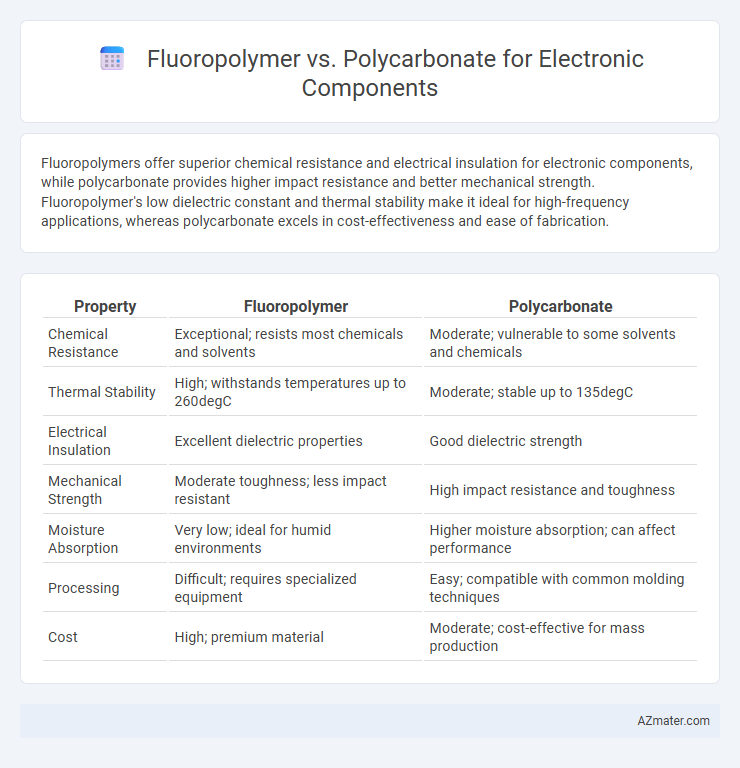Fluoropolymers offer superior chemical resistance and electrical insulation for electronic components, while polycarbonate provides higher impact resistance and better mechanical strength. Fluoropolymer's low dielectric constant and thermal stability make it ideal for high-frequency applications, whereas polycarbonate excels in cost-effectiveness and ease of fabrication.
Table of Comparison
| Property | Fluoropolymer | Polycarbonate |
|---|---|---|
| Chemical Resistance | Exceptional; resists most chemicals and solvents | Moderate; vulnerable to some solvents and chemicals |
| Thermal Stability | High; withstands temperatures up to 260degC | Moderate; stable up to 135degC |
| Electrical Insulation | Excellent dielectric properties | Good dielectric strength |
| Mechanical Strength | Moderate toughness; less impact resistant | High impact resistance and toughness |
| Moisture Absorption | Very low; ideal for humid environments | Higher moisture absorption; can affect performance |
| Processing | Difficult; requires specialized equipment | Easy; compatible with common molding techniques |
| Cost | High; premium material | Moderate; cost-effective for mass production |
Overview of Fluoropolymer and Polycarbonate
Fluoropolymers, characterized by high chemical resistance, excellent electrical insulation, and outstanding thermal stability, are widely used in electronic components requiring durability in extreme environments. Polycarbonate offers robust impact resistance, good electrical insulation, and cost-effectiveness, making it suitable for protective electronic housings and components under moderate thermal conditions. The choice between fluoropolymer and polycarbonate depends on the application's thermal, chemical, and mechanical requirements within electronic components.
Chemical Composition and Structure Comparison
Fluoropolymers consist of carbon-fluorine bonds, offering exceptional chemical resistance and low surface energy, making them ideal for electronic components exposed to harsh environments. Polycarbonate features a carbonate group within its aromatic polymer chain, providing high impact resistance and good dimensional stability under thermal stress. The distinct chemical structures result in fluoropolymers excelling in chemical inertness and dielectric properties, while polycarbonates provide superior mechanical strength and transparency.
Mechanical Properties: Strength and Flexibility
Fluoropolymers exhibit exceptional chemical resistance and flexibility, making them ideal for electronic components requiring durable insulation and flexibility under mechanical stress. Polycarbonate offers superior mechanical strength and impact resistance, providing rigid protection for electronic housings and components exposed to physical shocks. The choice between fluoropolymer and polycarbonate depends on the specific mechanical demands, with fluoropolymers favored for flexible insulation and polycarbonate preferred for structural rigidity.
Thermal Stability and Temperature Resistance
Fluoropolymers exhibit superior thermal stability and temperature resistance compared to polycarbonate, withstanding continuous use temperatures often exceeding 200degC, while polycarbonate typically endures up to 130degC. The high melting point and chemical inertness of fluoropolymers make them ideal for electronic components exposed to extreme heat and harsh environmental conditions. Polycarbonate, though mechanically robust and impact-resistant, deforms and loses properties under prolonged high temperatures, limiting its application in high-temperature electronic environments.
Electrical Insulation Capabilities
Fluoropolymers exhibit superior electrical insulation properties due to their high dielectric strength and low dielectric constant, making them ideal for applications requiring reliable performance in high-frequency and high-voltage environments. Polycarbonate offers good electrical insulation but has a higher dielectric constant and lower resistance to electrical breakdown compared to fluoropolymers, limiting its use in demanding electronic components. The chemical inertness and thermal stability of fluoropolymers further enhance their insulating capabilities, especially in harsh conditions where polycarbonate may degrade.
Optical Clarity and Transparency Differences
Fluoropolymers exhibit superior optical clarity and chemical resistance, making them ideal for electronic components requiring high transparency and durability in harsh environments. Polycarbonate offers excellent transparency and high impact resistance but is prone to yellowing and reduced clarity over time when exposed to UV light. For applications demanding long-term optical performance and environmental stability, fluoropolymers provide a more reliable solution than polycarbonate.
Chemical and Environmental Resistance
Fluoropolymers exhibit superior chemical resistance compared to polycarbonate, offering exceptional stability against solvents, acids, and bases which is crucial for protecting sensitive electronic components. Their resistance to UV radiation and extreme environmental conditions ensures long-term durability in harsh operational environments. In contrast, polycarbonate, while offering good mechanical strength, is more susceptible to chemical degradation and environmental stress cracking, limiting its use in chemically aggressive or highly corrosive settings.
Ease of Fabrication and Machinability
Fluoropolymers exhibit excellent chemical resistance and thermal stability, but their fabrication and machinability can be challenging due to high melting points and low surface energy, often requiring specialized tools and procedures. Polycarbonate offers superior ease of fabrication with its excellent dimensional stability, impact resistance, and compatibility with conventional machining and molding techniques, making it ideal for rapid prototyping and complex component designs. Manufacturers prioritize polycarbonate for electronic components when precision machining and cost-effective production are critical, whereas fluoropolymers are favored in harsh chemical environments despite the increased fabrication complexity.
Cost Implications and Material Availability
Fluoropolymers generally have higher cost implications than polycarbonate due to their specialized chemical resistance and thermal stability, making them less economically feasible for large-scale electronic component manufacturing. Polycarbonate offers greater material availability and affordability, supporting high-volume production while providing adequate impact resistance and electrical insulation properties. Manufacturers often select polycarbonate for cost-sensitive projects, whereas fluoropolymer is reserved for niche applications demanding superior durability under extreme environmental conditions.
Application Suitability for Electronic Components
Fluoropolymers exhibit exceptional chemical resistance, low dielectric constant, and high thermal stability, making them ideal for insulating materials and protective coatings in high-frequency and harsh-environment electronic components. Polycarbonate offers superior impact resistance, dimensional stability, and ease of fabrication, which suits enclosures and structural parts where mechanical durability and transparency are necessary. Selecting between fluoropolymer and polycarbonate depends on the specific electronic component requirements, with fluoropolymers favored in chemically aggressive or high-temperature settings, while polycarbonate excels in mechanical protection and aesthetic applications.

Infographic: Fluoropolymer vs Polycarbonate for Electronic Component
 azmater.com
azmater.com